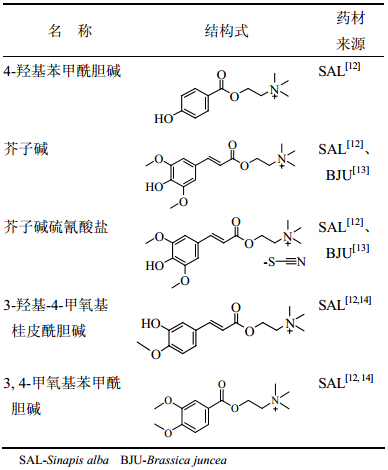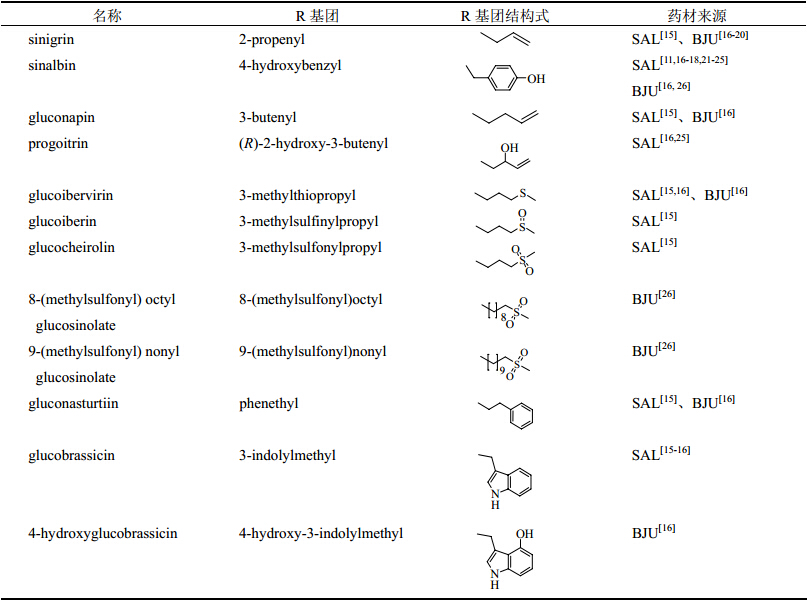2. 江苏省中医药研究院和中国中医科学院江苏分院 中药代谢组研究室, 江苏 南京 210028;
3. 中国药科大学 天然药物活性组分与药效国家重点实验室, 江苏 南京 210009
2. Department of Metabolomics, Jiangsu Province Academy of Traditional Chinese Medicine and Jiangsu Branch of China Academy of Chinese Medical Sciences, Nanjing 210028, China;
3. The State Key Laboratory of Natural Medicines Components and Pharmcodynamics, China Pharmaceutical University, Nanjing 210009, China
芥子Sinapis Semen为十字花科(Brassicaceae)白芥属Sinapis L. 植物白芥Sinapis alba L. 或芥Brassica juncea (L.) Czern. et Coss. 的干燥成熟种子。前者习称“白芥子”,后者习称“黄芥子”。其性温,味辛,归肺经;具有温肺豁痰利气、散结通络止痛之功效[1]。近年来研究表明芥子中主要化学成分为硫代葡萄糖苷类和芥子碱类。芥子碱类成分具有抗氧化、抗雄性激素、缓慢降压等多种药理活性[2,3,4,5,6,7];硫代葡萄糖苷类成分及其降解产物具有镇咳平喘、抗氧化、抗癌、抗菌等功效[8,9,10]。本文对芥子中芥子碱类和硫代葡萄糖苷类成分的化学组成、稳定性和质量控制方法进行归纳总结,希望对芥子药材及其相关产品的质量控制和合理开发利用提供科学指导。 1 化学组成 1.1 芥子碱类成分
芥子中主要含有4种芥子碱类成分,包括芥子碱(sinapine)、4-羟基苯甲酰胆碱(4-hydroxyben- zoylcholine)、3-羟基-4-甲氧基桂皮酰胆碱(iso- feruoylcholine)和3,4-甲氧基苯甲酰胆碱(hesperalin)。白芥子较黄芥子含有更丰富的芥子碱类成分,其中量较高的4-羟基苯甲酰胆碱常作为鉴别白芥子药材的指标性成分[11]。芥子碱在植物中的主要存在形式为芥子碱硫氰酸盐(sinapine thiocyanate),为白芥子和黄芥子共有的成分(表 1)。
| 表 1 芥子中芥子碱类成分 Table 1 Sinapinoids in Sinapis Semen |
特征性成分,此类成分是由一个含糖基团、硫酸盐基团和可变的非糖侧链(R)组成(图 1),基于R基团的不同,硫代葡萄糖苷可以分为3类:脂肪族硫代葡萄糖苷、芳香族硫代葡萄糖苷和吲哚硫代葡萄糖苷。白芥子和黄芥子中含有的硫代葡萄糖苷类成分归纳见表 2。从表中可以看出,sinigrin和sinalbin分别为黄芥子和白芥子中特有的硫代葡萄糖苷类成分,但Lee等[15]在白芥子中未检测到sinalbin,Fabre等[26]在黄芥子中未检测到sinigrin,却发现大量sinalbin。
 | 图 1 硫代葡萄糖苷母核 Fig. 1 Skeleton of glucosinolates |
| 表 2 芥子中所含主要硫代葡萄糖苷类成分 Table 2 Glucosinolates in Sinapis Semen |
研究表明芥子中硫代葡萄糖苷类成分和芥子碱类成分均在特定条件下易发生降解。其中硫代
葡萄糖苷会在酶、高温和微生物等条件下发生分解[27,28],芥子碱也会在酶、碱和高温等条件下发生降解[29,30,31]。本文对芥子中最具代表性的芥子碱、sinigrin和sinalbin的稳定性和相关降解规律进行总结。 2.1 芥子碱的稳定性
Vuorela等[31]考察了芥子碱在NaOH和6种不同的酶及酶制剂(esterase、β-glucosidase、ferulic acid esterase、Ultraflo L、Viscozyme L和Celluclast)环境下的水解规律,发现在NaOH、ferulic acid esteras(FAE)和Ultraflo L下90%的芥子碱都转化为芥子酸(图 2),而在酸性条件下能稳定存在。最近研究表明芥子碱在碱性和相关酶作用下转化为芥子酸,而后在微波处理干预下会脱羧转化成脂溶性的抗氧化剂canolol(4-vinylsyringol)(图 2)。Khattab等[30]研究发现在碱性条件下芥子碱的水解率约为80%,之后再利用300 W微波处理12 min约有58.3%芥子酸转化为canolol。Yang等[29]对芥子碱的稳定性进行研究,考察微波时间(0、1、2、3、4、5、6、7、8 min)对芥子碱和canolol量的影响,结果发现canolol的量会随着微波时间增加而增加,芥子碱随着微波时间延长先增加后急剧降低,推测微波可增加芥子碱的提取率,但随着微波时间延长会使温度过高,芥子碱便转化为canolol。
 | 图 2 芥子碱水解和脱羧反应 Fig. 2 Alkaline hydrolysis and decarboxylation of sinapine |
硫代葡萄糖苷在芥子酶存在下生成的中间产物在外界条件(pH、金属离子及蛋白等)干扰下发生重排,降解为腈类(nitriles)、异硫氰酸酯类(isothiocyanates)、硫氰酸酯类(thiocyanates)、恶唑烷(oxazolidines)和环硫腈(epithionitrile)(图 3)。
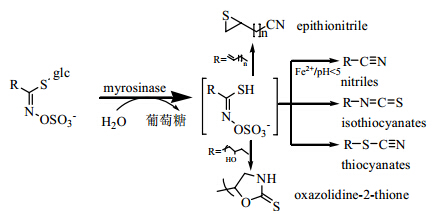 | 图 3 硫代葡萄糖苷降解规律及主要降解产物 Fig. 3 Ruleof enzymic glucosinolate degradation and its main degradation products |
早年Kawakishi等[23,24]发现sinalbin是白芥子中量最高的硫代葡萄糖苷类成分,并对其与芥子酶在不同条件下生成的降解产物进行了鉴别。Buskov等[32]采用超临界流体色谱系统研究了芥子 中sinalbin的分解规律,并对各降解产物在不同条件下的稳定性进行了考察。Vaughn等[33]也对不同pH条件下的sinalbin降解产物进行了鉴定。通过以上研究发现,在pH 7条件下sinalbin会发生lossen重排(图 4),生成约96%的硫代异氰酸对羟苄酯(4- hydroxybenzyl isothiocyanate),而在酸性条件下会生成25%的对羟基苯乙腈(4-hydroxybenzyl nitrile),降解途径中硫代异氰酸对羟苄酯(4-hydroxybenzyl isothiocyanate)会脱去SCN-得到一中间产物,中间产物根据底物环境的不同而生成不同产物,主要生成对羟基苯乙醇(4-hydroxybenzyl alcolhol),降解过程见图 5。SCN-与sinapine结合形成sinapinethiocyanate,是sinapine在白芥子中存在的最主要形式。Josefsson等[34]研究发现在碱性条件下异硫氰酸酯(isothiocyanate)会分解完全并产生SCN-。Borek等[25]对白芥子中SCN-的产生机制进行深入研究表明,在pH 4~7得到SCN-的量与pH无关,但pH 7时转化最快,并发现SCN-的产生与sinapine的降解无关。
 | 图 4 硫代葡萄糖苷Lossen重排转化为异硫氰酸酯 Fig. 4 Lossen like rearrangement of glucosinolates to give isothiocyanates |
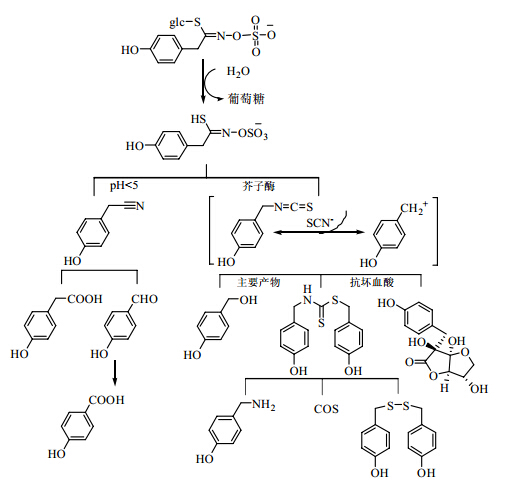 | 图 5 Sinalbin降解及相关产物 Fig. 5 Degradation of sinalbin and its related products |
上述研究表明sinalbin会在芥子酶存在下降解。中药传统通过炒制达到杀酶保苷的目的,以防止硫代葡萄糖苷发生分解。逄镇等[22]对白芥子生品和炒制后药材的指纹图谱进行比较,发现在水提取时生品白芥子中sinalbin发生降解,而炒制后相应成分得以保留,揭示了炒制后杀酶保苷的意义。郁露等[35]通过红外及二维相关光谱动态跟踪白芥子炒制过程中成分变化,发现在高温炒制过程中,油脂类吸收带强度变化不大,但蛋白质吸收带强度显著降低,表明蛋白质(酶)发生了热变性,从分子光谱水平上揭示了白芥子药材炒制“杀酶保苷”的意义。 2.2.2 硫代葡萄糖苷的热稳定性
芥子在使用前常进行炒制,起到杀酶保苷的作用,但炒制时温度较高,传统水煎时也会长时间处在100 ℃高温下。高温对芥子中所含有的硫代葡萄糖苷成分的稳定性也会产生显著影响[27,28]。
MacLeod等[36]利用气相色谱法分析发现,在柱温200 ℃下,脂肪族和芳香族硫代葡萄糖苷会发生分解(图 6)。杨雪萍等[37]通过比较白芥子炒制前后p-hydroxyphenyl acetonitrile的量,发现炒制后量增高,说明在非酶条件下sinalbin同样在高温下发生分解。
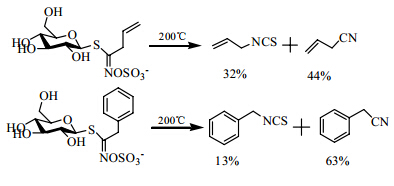 | 图 6 脂肪族和芳香族硫代葡萄糖苷的热解规律 Fig. 6 Thermal degradation of aliphatic and aromatic glucosinolates |
迄今为止对芥子中芥子碱的分析多采用薄层色谱法(TLC)和高效液相色谱-紫外光谱法(HPLC-UV),主要选用苯基柱和C18柱。由于芥子碱在碱性条件下会转变为芥子酸,所以在液相色谱分析时普遍加入酸性物质保证芥子碱的稳定性(表 3)。
| 表 3 芥子中芥子碱的分析方法总结 Table 3 Analytical methods of sinapine in Sinapis Semen |
对芥子中硫代葡萄糖苷的分析主要采用气相色谱法(GC)[16]和HPLC法[17,19]。利用GC分析硫代葡萄糖苷原型时高温条件可能会是使其分解,故主要利用GC分析硫代葡萄糖苷的分解产物异硫氰酸酯等挥发性成分[36,45,46];采用液相色谱与紫外光谱联用(LC-UV)分析多种硫代葡萄糖苷类物质时,芥子中硫代葡萄糖苷成分结构相似,且检测波长多在227 nm,基质(如甲醇、甲酸等)对硫代葡萄糖苷的分析影响较大,导致分离效果不佳[15]。
液相色谱与质谱(mass spectrometry)联用技术已被应用于分析结构类似的硫代葡萄糖苷类成分,使分离和鉴定更准确[15],分析芥子中含有的硫代葡萄糖苷类物质多采用电喷雾离子阱质谱(electrospray ion trap mass spectrometry,ESI-IT-MS)[15,21,47,48]、快原子轰击质谱(fast atom bombardment mass spectrometry,FAB-MS)[49,50,51,52]、电喷雾四极杆飞行时间质谱(Electrospray quadrupole-time-of-flight mass spectrometry,ESI-Q-TOF-MS)[22]、电喷雾三重四级杆质谱(electrospray triple-quadrupole tandem mass spectrometer,ESI-TQ-MS)[53]及电喷雾傅里叶变换离子回旋共振质谱(electrospray fourier transformion cyclotron resonance mass spectrometer,ESI- FTICRMS)[48]等;对芥子碱类物质的分析多采用LC/ESI-Q-TOF-MS[54]和ESI- IT-MS[55]。 3.2 质量评价研究 3.2.1 定性评价研究
目前常采用TLC、GC和HPLC鉴别白芥子和黄芥子[11,16,38]。TLC和HPLC- UV用于鉴别白芥子中芥子碱硫氰酸盐、sinalbin和4-羟基苯甲酰胆碱。Sinigrin和sinalbin可作为区别黄芥子和白芥子的指标[16]。
近年来多采用质谱技术分析芥子中硫代葡萄糖苷和芥子碱类成分。现将芥子中量较高的芥子碱、sinigrin和sinalbin的质谱裂解规律和离子碎片进行总结,见图 7、8和表 4>。
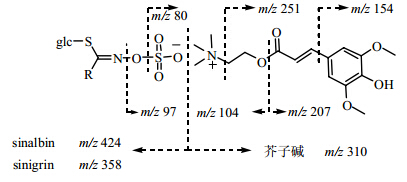 | 图 7 Sinalbin,sinigrin和芥子碱的常见质谱裂解 Fig. 7 Proposed fragmentation patterns for sinalbin,sinigrin,and sinapine |
 | 图 8 硫代葡萄糖苷常见裂解 Fig. 8 Proposed fragmentation patterns of glucosinolates |
| 表 4 Sinigrin,sinalbin和芥子碱常用质谱分析技术及主要碎片离子 Table 4 Commonly-used MS methods and fragment ions for sinigrin,sinalbin,and sinapine |
(1)气相色谱法:芥子中硫代葡萄糖苷和挥发油成分主要采用气相色谱法分析。文献中报道的样品前处理有直接水煎煮提取[56,57],将硫代葡萄糖苷水解成异硫氰酸烯丙酯后提取[45,46]和直接采用顶空萃取技术处理样品[58]。结果表明水解后提取挥发油 的量最高,炒制后样品挥发油中异硫氰酸稀丙酯的量明显降低,结果见表 5。
| 表 5 气相色谱在芥子分析中的应用 Table 5 Application of GC in analysis of Sinapis Semen |
(2)液相色谱法:目前主要采用液相色谱法测定芥子中芥子碱的量,并应用于芥子药材的资源、品种和炮制前后的比较研究,以及对相关产品的质量进行控制(表 6)。
| 表 6 液相色谱法在芥子及相关产品分析中的应用 Table 6 Application of HPLC in analysis of Sinapis Semen and its related products |
芥子碱类和硫代葡萄糖苷类是芥子中主要的化学成分,硫代葡萄糖苷类化合物热不稳定,气相色谱不适合作为芥子质量控制的方法,而液相色谱能 同时分析芥子中硫代葡萄糖苷和芥子碱类成分,可建立相关色谱指纹图谱用于整体质量评价。由于硫代葡萄糖苷类和芥子碱类成分的不稳定性,药材干燥和炮制方式都对芥子有效成分的组成和量产生明显影响,干燥和炮制工艺必须规范化才能保证药材质量稳定。
作为常用中药,芥子仍有许多科学问题值得深入研究:(1)《中国药典》2010年版将白芥子和黄芥子统称为芥子,但它们同科不同属,成分上差异较大,尤其是对两种来源芥子中硫代葡萄糖苷类成 分上的争议较大。大多研究者[11,16,17,18,19,20,21,22,23,24,25]认为sinigrin为黄芥子特有,而sinalbin为白芥子特有的硫代葡萄糖苷,但Fabre等[26]在黄芥子中检测到sinalbin而未发现sinigrin,Lee等[15]在白芥子中只检测到sinigrin未发现sinalbin的存在。在提取白芥子挥发油时多采用将硫代葡萄糖苷水解后提取挥发油,挥发油中异硫氰酸烯丙酯的量最高,但炒制后样品挥发油中异硫氰酸烯丙酯的量降低,而2-丁烯氰的量大幅增加。结合硫代葡萄糖苷的降解规律推测由于sinigrin水解后产生异硫氰酸烯丙酯从而挥发油的量增高,炒制后sinigrin发生热分解,导致2-丁烯氰量增加,异硫氰酸烯丙酯的量明显降低。但sinigrin为黄芥子特有的硫代葡萄糖苷,其降解产物却在白芥子挥发油提取得到。上述问题是否由于市面上芥子的品种混杂而导致值得深入研究。(2)梁燕等[59]研究发现芥子炒制后芥子碱量增高,但张村等[38]和刘起华等[41]研究发现炒制后芥子碱的量降低;逢镇等[22]提出炒制可达到杀酶保苷的作用,但杨雪萍等[37]发现白芥子炒制后sinalbin同样发生分解,提出杀酶保苷存在局限。药材在炮制前后化学成分的量变化趋势存在相反结果是否与硫代葡萄糖苷和芥子碱类成分对高温敏感或受炮制时间的影响有待进一步研究。(3)当前广泛使用的体现中药汤剂特色的芥子配方颗粒质量及相关标准也未见深入研究。研究探讨芥子配方颗粒制备过程(煎煮、浓缩和制剂等)中的化学成分转化与药效的关联性和质量控制方法,是保证芥子临床应用安全有效和质量稳定可控的切实可行的措施。
| [1] | 凌一揆. 中药学 [M]. 上海: 上海科学技术出版社, 1984. |
| [2] | 吴国欣, 林跃鑫, 欧敏锐, 等. 芥子碱的抗雄激素作用 [J]. 中国医药学报, 2003, 18(3): 142-144. |
| [3] | 张明发, 沈雅琴. 芥子碱的抗炎和抗腹泻作用 [J]. 中药药理与临床, 1996, 12(1): 29-31. |
| [4] | 张福华. 芥子碱的抗肿瘤血管生成作用及其机制探讨 [D]. 福州: 福建师范大学, 2012. |
| [5] | 李 晶, 石 卓, 赵丽娟, 等. 芥子碱硫酸氢盐对自发性高血压大鼠血压和心率的影响 [J]. 吉林中医药, 2002, 22(6): 55-56. |
| [6] | 王 辉, 苑艳霞, 邱 琳, 等. 芥子碱平喘作用及其机制研究 [J]. 中草药, 2011, 42(1): 134-136. |
| [7] | 柯木根, 吴国欣, 林燕妮, 等. 芥子碱的研究概况 [J]. 中草药, 2007, 38(9): 1436-1439. |
| [8] | 吴圣曦. 白芥子挥发油抗肿瘤作用初步研究 [D]. 福州: 福建师范大学, 2010. |
| [9] | 余正江. 白芥子化学成分及镇咳活性研究 [D]. 沈阳: 沈阳药科大学, 2005. |
| [10] | Valgimigli L, Iori R. Antioxidant and pro-oxidant capacities of ITCs [J]. Environ Mol Mutag, 2009, 50(3): 222-237. |
| [11] | 张 村, 李 丽, 肖永庆, 等. 芥子不同品种的色谱对应鉴别 [J]. 中国实验方剂学杂志, 2010, 16(14): 38-40. |
| [12] | Clausen S, Olsen O, Sorensen H. 4- Hydroxybenzoylcholine: A natural product present in Sinapis alba [J]. Phytochemistry, 1982, 21(4): 917-922. |
| [13] | 刘丽芳, 王宇新, 李海燕, 等. 常用十字花科药用植物中芥子碱的分布研究 [J]. 色谱, 2006, 24(1): 49-51. |
| [14] | 杨雪萍, 王惠国, 冯宝民, 等. 芥子中总芥子碱类成分的含量测定 [J]. 大连大学学报, 2009, 15(6): 53-55. |
| [15] | Lee K C, Chan W, Liang Z, et al. Rapid screening method for intact glucosinolates in Chinese medicinal herbs by using liquid chromatography coupled with electrospray ionization ion trap mass spectrometry in negative ion mode [J]. Rapid Commun Mass Spectrom, 2008, 22(18): 2825-2834. |
| [16] | Velíšek J, Mikulcová R, Míková K, et al. Chemometric investigation of mustard seed [J]. LWT-Food Sci Technol, 1995, 28(6): 620-624. |
| [17] | Herzallah S, Holley R. Determination of sinigrin, sinalbin, allyl-and benzyl isothiocyanates by RP-HPLC in mustard powder extracts [J]. LWT-Food Sci Technol, 2012, 47(2): 293-299. |
| [18] | Szmigielska A M, Schoenau J J. Use of anion-exchange membrane extraction for the high-performance liquid chromatographic analysis of mustard seed glucosinolates [J]. J Agric Food Chem, 2000, 48(11): 5190-5194. |
| [19] | Rangkadilok N, Nicolas M E, Bennett R N, et al. Determination of sinigrin and glucoraphanin in Brassica species using a simple extraction method combined with ion-pair HPLC analysis [J]. Sci Horticult, 2002, 96(1): 27-41. |
| [20] | Hill C, Williams P, Carlson D, et al. Variation in glucosinolates in oriental Brassica vegetables [J]. J Am Soc Horticult Sci, 1987, 112(2): 309-313. |
| [21] | Fabre N, Poinsot V, Debrauwer L, et al. Characterisation of glucosinolates using electrospray ion trap and electrospray quadrupole time-of-flight mass spectrometry [J]. Phytochem Anal, 2007, 18(4): 306-319. |
| [22] | 逄 镇, 张 村, 李 丽, 等. 白芥子及其炮制品的HPLC鉴别 [J]. 北京中医药大学学报, 2008, 31(10): 699-701. |
| [23] | Kawakishi S, Muramatsu K. Studies on the decomposition of sinalbin part I. The decomposition products of sinalbin (1) [J]. Agric Biol Chem, 1966, 30(7): 688-692. |
| [24] | Kawakishi S, Namiki M, Watanabe H. Studies on the decomposition of sinalbin part II. The decomposition products of sinalbin and their degradation pathways [J]. Agric Biol Chem, 1967, 31(7): 823-830. |
| [25] | Borek V, Morra M J. Ionic thiocyanate (SCN-) production from 4-hydroxybenzyl glucosinolate contained in Sinapis alba seed meal [J]. J Agric Food Chem, 2005, 53(22): 8650-8654. |
| [26] | Fabre N, Bon M, Moulis C, et al. Three glucosinolates from seeds of Brassica juncea [J]. Phytochemistry, 1997, 45(3): 525-527. |
| [27] | Bones A M, Rossiter J T. The enzymic and chemically induced decomposition of glucosinolates [J]. Phytochemistry, 2006, 67(11): 1053-1067. |
| [28] | Hanschen F S, Bauer A, Mewis I, et al. Thermally induced degradation of aliphatic glucosinolates: identification of intermediary breakdown products and proposed degradation pathways [J]. J Agric Food Chem, 2012, 60(39): 9890-9899. |
| [29] | Yang M, Zheng C, Zhou Q, et al. Influence of microwaves treatment of rapeseed on phenolic compounds and canolol content [J]. J Agric Food Chem, 2014, 62(8): 1956-1963. |
| [30] | Khattab R Y, Eskin M N A, Thiyam-Hollander U. Production of canolol from canola meal phenolics via hydrolysis and microwave-induced decarboxylation [J]. J Am Oil Chem Soc, 2014, 91(1): 89-97. |
| [31] | Vuorela S, Meyer A S, Heinonen M. Quantitative analysis of the main phenolics in rapeseed meal and oils processed differently using enzymatic hydrolysis and HPLC [J]. Eur Food Res Technol, 2003, 217(6): 517-523. |
| [32] | Buskov S, Hasselstrøm J, Olsen C E, et al. Supercritical fluid chromatography as a method of analysis for the determination of 4-hydroxybenzylglucosinolate degrada- tion products [J]. J Biochem Biophys Methods, 2000, 43(1): 157-174. |
| [33] | Vaughn S F, Berhow M A. Glucosinolate hydrolysis products from various plant sources: pH effects, isolation, and purification [J]. Ind Crops Prod, 2005, 21(2): 193-202. |
| [34] | Josefsson E. Method for quantitative determination of p-hydroxybenzyl isothiocyanate in digests of seed meal of Sinapis alba L [J]. J Sci Food Agric, 1968, 19(4): 192-194. |
| [35] | 郁 露, 孙素琴, 周 群, 等. 白芥子炒制过程的红外及二维相关光谱研究 [J]. 光谱学与光谱分析, 2006, 26(12): 2181-2185. |
| [36] | MacLeod A J, Panesar S S, Gil V. Thermal degradation of glucosinolates [J]. Phytochemistry, 1981, 20(5): 977-980. |
| [37] | 杨雪萍, 王惠国, 冯宝民, 等. 白芥子炒制前后对羟基苯乙腈含量的变化 [J]. 沈阳药科大学学报, 2010, 27(8): 623-625. |
| [38] | 张 村, 李 丽, 肖永庆, 等. 白芥子饮片的质量评价研究 [J]. 中国实验方剂学杂志, 2010, 16(16): 30-32. |
| [39] | 刘丽芳, 王宇新, 刘雪芳, 等. HPLC法测定白芥子药材中芥子碱硫氰酸盐的含量 [J]. 中国野生植物资源, 2001, 20(5): 49-50. |
| [40] | 王海波. 不同产地白芥子和黄芥子中芥子碱硫氰酸盐的含量比较 [J]. 中医研究, 2012, 25(1): 68-70. |
| [41] | 刘起华, 张 萱, 文 谨. 白芥子不同炮制品中芥子碱硫氰酸盐含量测定 [J]. 中国中医药信息杂志, 2007, 14(11): 46-47. |
| [42] | 桂 洁, 汪永忠, 夏伦祝, 等. UPLC法测定阳和平喘颗粒中芥子碱硫氰酸盐的含量 [J]. 海峡药学, 2013, 25(3): 42-43. |
| [43] | 赵杰余, 刘金来, 李笑慧, 等. HPLC法测定"冬病夏治"贴膏中芥子碱硫氰酸盐含量 [J]. 海峡药学, 2013, 25(8): 78-80. |
| [44] | 韩保民, 刘金来, 李笑慧, 等. 不同温度对冬病夏治膏药中芥子碱硫氰酸盐含量的影响 [J]. 中国药师, 2012, 15(6): 798-800. |
| [45] | 吴圣曦, 赖兰香, 吴国欣, 等. 白芥子挥发油提取工艺优化及其化学成分鉴定 [J]. 中华中医药杂志, 2010, 25(5): 680-682. |
| [46] | 曹 银, 李 曼, 汪电雷, 等. 气相色谱法测定白芥子挥发油中异硫氰酸烯丙酯的含量 [J]. 安徽中医学院学报, 2013, 32(3): 78-80. |
| [47] | Rochfort S J, Trenerry V C, Imsic M, et al. Class targeted metabolomics: ESI ion trap screening methods for glucosinolates based on MSn fragmentation [J]. Phytochemistry, 2008, 69(8): 1671-1679. |
| [48] | Cataldi T R, Lelario F, Orlando D, et al. Collision- induced dissociation of the A+ 2 isotope ion facilitates glucosinolates structure elucidation by electrospray ionization-tandem mass spectrometry with a linear quadrupole ion trap [J]. Anal Chem, 2010, 82(13): 5686-5696. |
| [49] | Sakushima A, Ohnishi S, Kubo H, et al. Study of sinapinyl but-3-enylglucosinolate(boreavan A) and related compounds by mass spectrometry [J]. Phytochem Anal, 1997, 8(6): 312-315. |
| [50] | Kokkonen P, Van der Greef J, Niessen W, et al. Identification of intact glucosinolates using direct coupling of high-performance liquid chromatography with continuous-flow frit fast atom bombardment tandem mass spectrometry [J]. Biol Mass Spectrom, 1991, 20(5): 259-267. |
| [51] | Reinhoud N, Niessen W, Tjaden U, et al. Performance of a liquid-junction interface for capillary electrophoresis mass spectrometry using continuous-flow fast-atom bombardment [J]. Rapid Commun Mass Spectrom, 1989, 3(10): 348-351. |
| [52] | Kokkonen P, Van der Greef J, Niessen W, et al. Separation and identification of intact glucosinolates using direct coupling of high-performance liquid chromatography with frit to fast-atom bombardment mass spectrometry [J]. Rapid Commun Mass Spectrom, 1989, 3(4): 102-106. |
| [53] | Bialecki J B, Ruzicka J, Weisbecker C S, et al. Collision-induced dissociation mass spectra of glucosinolate anions [J]. J Mass Spectrom, 2010, 45(3): 272-283. |
| [54] | Böttcher C, von Roepenack-Lahaye E, Schmidt J, et al. Analysis of phenolic choline esters from seeds of Arabidopsis thaliana and Brassica napus by capillary liquid chromatography/electrospray-tandem mass spectrometry [J]. J Mass Spectrom, 2009, 44(4): 466-476. |
| [55] | 陈天文. 液相色谱-电喷雾离子阱质谱对芥子碱的测定方法 [J]. 分析试验室, 2008, 27(5): 115-117. |
| [56] | 刘 强, 张 璐, 易延逵, 等. 炒制对白芥子挥发油成分的影响 [J]. 中成药, 2007, 29(10): 1473-1475. |
| [57] | 颜世芬, 陈茂齐, 段志兴. 芥子挥发油化学成分研究 [J]. 中草药, 1994, 25(3): 162. |
| [58] | 蔡君龙, 卢金清, 黎 强, 等. 顶空固相微萃取-气相色谱-质谱联用分析白芥子挥发性化学成分 [J]. 中国药业, 2014, 23(4): 26-27. |
| [59] | 梁 燕, 赖庆水, 刘 强. 炒制对白芥子中芥子碱硫氰酸盐含量的影响 [J]. 南方医科大学学报, 2007, 27(10): 1579-1580. |
 2015, Vol. 46
2015, Vol. 46



